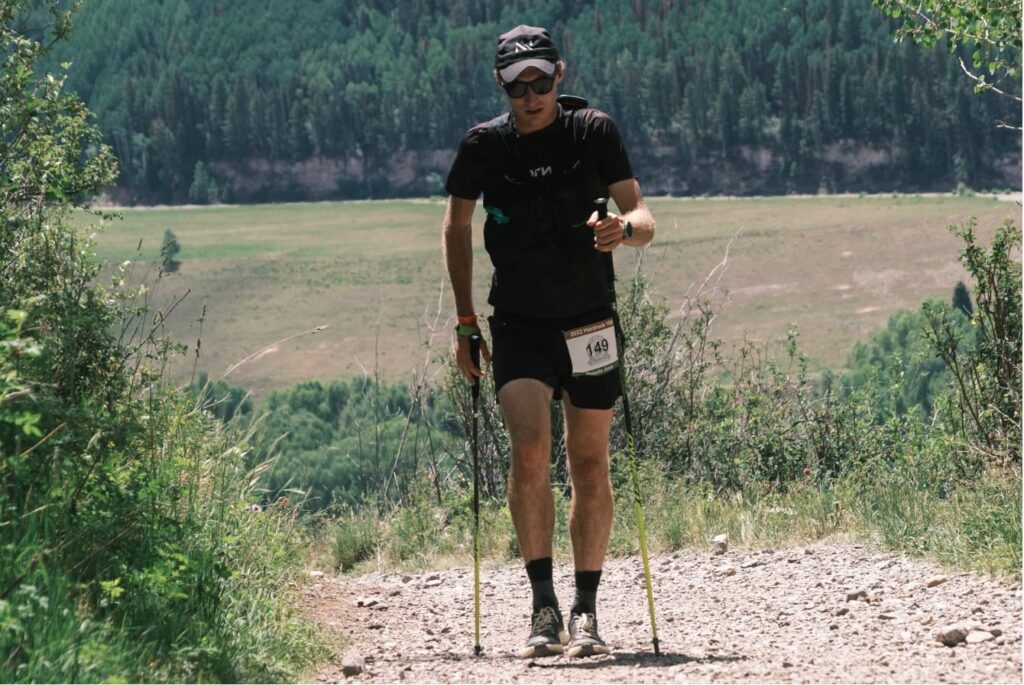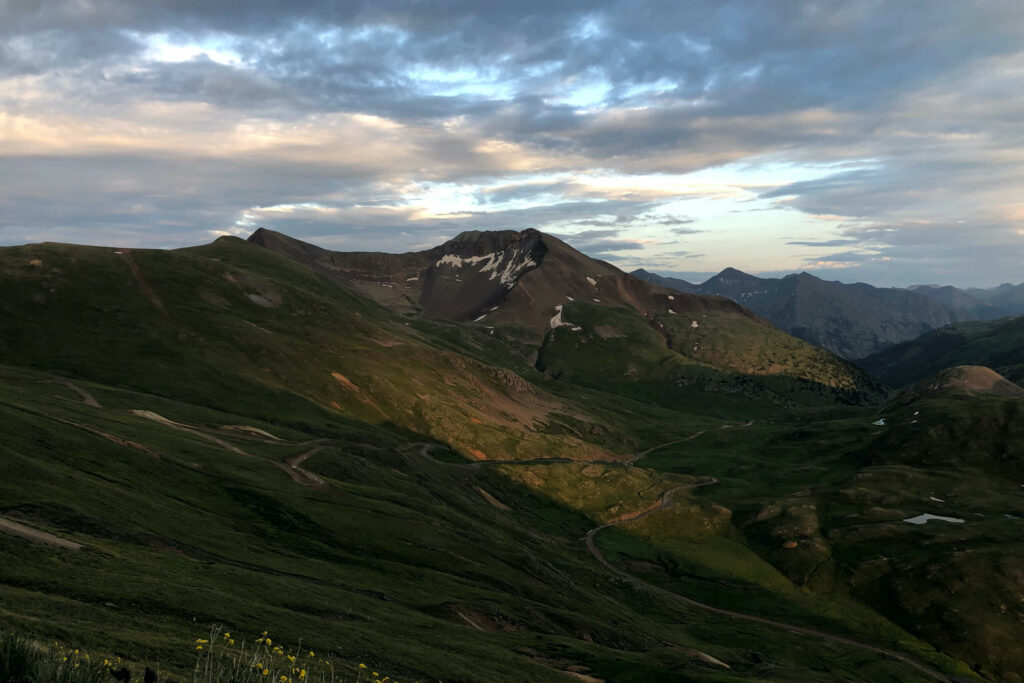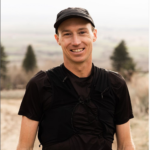Editors note: This is the first in a series of articles from Dakota Jones that will examine the intersection of environmentalism and the trail and ultrarunning community. Each piece will tell a story through personal reflection as Dakota highlights the progress and the mistakes he’s made along the way, including the incredible work that he is doing with Footprints Running – an incubator for climate action.
On a flight from Oakland to Denver several years ago, I struck up a conversation with the woman sitting beside me and discovered she worked as an aircraft mechanic in the Air Force. I’ve always thought it incredible that airplanes weighing many thousands of pounds can actually fly, and it turned out she was responsible not just for passenger planes but also the kind of aircraft that can lift off vertically and then break the speed of sound. As my sister says, our family is not composed of “hammer ready” people, so her job sounded like nothing less than wizardry.
I asked her to explain how airplanes can fly. She explained how the shape of the wings creates a tiny vacuum space on top of the wings (an “airfoil”) that gives the plane its ability to stay aloft in a fluid of vastly less density than the plane itself. It seemed like a fragile equilibrium. I quickly moved on to what I really wanted to know, which I assumed she was asked all the time: “Are you here in case the engines blow up mid-flight?”
She shook her head. “Unfortunately,” she explained, “if the engines blow up mid-flight there’s not much I can do. My job is to prevent that from happening at all.”
I considered the matter for a second, then persevered. “Well, what would happen if the engines did blow up while we were flying? Would we just crash to the ground in like ten seconds or what?”
A few people nearby looked worried and quickly put on headphones. But my neighbor seemed to enjoy the question. “Well, that’s actually pretty interesting,” she said. “A lot of people think you’d just nose-dive into the ground, because that’s what happens in the movies. But the plane would actually follow a kind of stair-step motion as we descended.”
She went on to explain that if the engines were to stop working mid-flight, the airplane would quickly lose speed. Speed is what gives the airplane lift, so it would then nose-dive and accelerate rapidly toward the ground. But that acceleration would also increase the lift, and the plane would level out briefly before losing speed again – repeating the process. This would continue in a haphazard manner until we did, indeed, crash into the ground.

I’d never considered that. And apparently she’d never considered running long distances through the mountains, which is what I do for a living. When she asked about my job and I explained that I run ultramarathons, that I was in fact just returning from a 50-mile race, she then asked me the question I get all the time: “what’s the farthest you’ve ever run?”
Anyone who runs trail races knows that “running” is a liberal term. We may be in short shorts and running shoes, but trail races tend to go up and down an awful lot. When the race is long enough or the climbs steep enough, it’s often much more efficient to hike than to run. Indeed, my preferred type of race is one that is steep and technical and long, so my races usually involve quite a bit of hiking. But it’s not like I’m slowing down mid-race to enjoy the scenery: it’s just that hiking is often the most efficient way to get up and down mountains. Hiking quickly and at a high intensity is really a skill in its own right, and it takes a lot of experience to be able to decipher when to run and when to hike in order to maximize your efficiency. So with this in mind, and being predisposed to a level of honesty that may have been unnecessary, I asked my companion in return if these races that involved hiking counted or if she was asking about how far I had ever truly run without stopping at all.
She considered for a moment, then said, “Ummm, how far have you ever run at once? Like, really run, not hiked?”
I hadn’t expected that. In trail runner world, hiking totally counts too, and for some reason I’d assumed she would be able to divine that. But since she asked, I had to tell her, and it took some thinking about, because I only ever count the runs I care about and the runs I care about nearly always involve hiking. When it really came down to it, I figured I’d only ever truly run like maybe 25 miles in one go, probably. I wasn’t actually sure. “Call it a marathon,” I said. And she said, “Okay. Wow. Cool.” And then we sort of stopped talking for a while.
Many years later there was a global pandemic, and during this time I went more than 18 months without getting on an airplane. Actually, I hadn’t flown for nearly a year before the pandemic even started, because I had gone to great lengths to reduce my personal carbon emissions. In the early years of my racing career, I had the opportunity to fly all around the world to run cool races, and I took liberal advantage of those opportunities. But in my head I was increasingly struggling with an irony that many of us encounter in this sport: as a mountain runner who idealizes wild places, I have a strong personal connection to and reverence for the natural world. My sense of self is partly founded on this connection. But the way I live and experience the natural world is enabled by fossil fuels, which are causing tremendous environmental damage. This represents a fundamental contradiction that has steadily overwhelmed my ability to rationalize my lifestyle.
I have sought ways to do it all, to find ways to travel and compete without leaving so much carbon detriment in my wake. But anyone who seeks true objectivity when encountering environmental problems is eventually going to come to a depressing logical conclusion; specifically, our very existence causes damage to the world. We all have an impact, and because of the way our society is structured, our impacts are larger than ever before – resulting in far-off unintended consequences. You can change your light bulbs, bike to work, and make sure to recycle every can you ever see, but your net impact will still be negative in a world founded on the idea of infinite growth and powered by fossil fuels. If you’re curious, check out this article demonstrating that even a homeless person, with no car, job, or income, will generate about 8.5 tons of carbon per year. Clearly, this is a systemic issue whose solution is out of reach of the individual.
When I started trying to confront this issue, I did what many of us do: I started with my own individual impacts. I thought, “Hey, I can’t talk to people about climate change if I’m still contributing to it, right?” And since I’m an endurance athlete with a taste for crazy ideas (and the socioeconomic privilege to take economic risks), I went to somewhat extreme lengths to do better. In addition to the small, unsexy things like not buying single-use plastic, going vegetarian, and never using a clothes dryer, I specifically focused on the way I traveled. We all know cars and airplanes emit a lot of carbon, so I tried to remove those from my equation. In 2016, I wanted to race in Europe, so instead of flying I worked out how to take a cargo ship across the Atlantic. And in 2018, when I wanted to run the Pikes Peak marathon, I decided to ride my bike there and back.

These were worthwhile efforts because they connected me deeply to the environmental causes I care most about. When I struggled, I felt better emotionally because I knew I struggled for something that mattered, something that was bigger than myself. But the same quest for authenticity that caused me to take those trips also inspired me to analyze them critically, and I had to contend with some difficult realizations: specifically, these things weren’t enough.
I had gone to huge lengths to reduce my impacts and set an example, doing things that were essentially out of reach of the normal person, and they still weren’t enough. They were difficult and exhausting and passion-driven, and still they were not enough. Climate change kept marching forward, and no matter how authentic my intentions were, my actions still were not enough – to make a difference.
There are a lot of ways to explain why this is the case, but the best answer is explained in this article which highlights that the term “carbon footprint” was invented by BP (British Petroleum) as a marketing scam to move the responsibility for climate change from the big corporations that caused it onto the individuals who can have no impact. By encouraging everyone to reduce their carbon footprint, BP told us that we were the problem, not the “giant oil conglomerate, who just a decade ago leaked hundreds of millions of gallons of oil into the Gulf of Mexico.”
The simple fact is that big corporations like BP have used money and political influence to create a global system wherein individuals have no choice but to use fossil fuels every single day. Then they manipulate the conversation on the topic to imply that individuals are the cause of this problem. This is only one example of the kind of effective greenwashing that has created a sense of shame for the individual and has resulted in tremendous infighting among environmentalists. People like me, who have passion and energy to put a stop to this problem spend years wasting our time focused on individual impacts because we fear the retaliation of our peers. Of being an imperfect environmentalist. But there is no way to live in the modern world without using fossil fuels because they have been intentionally woven into every aspect of the modern world. The answer to climate change is not to accuse each other of producing carbon; it’s to accept that we have no choice but to do so and to band together to create a world powered without fossil fuels. We have to speak with one voice if we want to be loud enough to overwhelm the corporate giants.
In the case of my racing career, these attempts at carbon reduction essentially took the form of not flying as much, and resulted in a foreseeable nose dive off the podium. Even though I tried to travel without carbon, it’s easier to save carbon by not traveling at all, and it’s hard to stay relevant in a competitive sport if you don’t show up to races. In a way, my career has been a bit like the airplane whose engines have stopped mid-flight. I lose focus and interest for a while, and my career plummets towards obscurity. But then I go win a race and claw back to a level of relative equilibrium that is generally lower than in previous years. Then I take more time off from traveling for climate concerns and start plummeting again. By 2019, I’d reached a point where the only question remaining was, how high up was I when I lost engine power, and when will I hit the ground?
But then I went to school, and I kept racing, and I thought deeply about why the running community matters so much to me. Over time, these things started to coalesce into answers. I began to understand that we have to use our existing energy system to create the new one. I started to see connections between these big global problems and our own niche sport of trail running.
By 2019, I’d reached a point where the only question remaining was, how high up was I when I lost engine power, and when will I hit the ground?
Climate change is a problem with vastly larger consequences than trail running. However, its effects on our sport are immediate and personal and we can use this shared love to galvanize action that will have broader effects. But no one can do this alone, which is why I’ve asked dozens of experts from around the world for help. At our Footprints running camps, we’re putting these ideas to work every day; our participants are creating effective climate solutions that are being implemented in communities around the country. While we are all individuals and our sport is small, when we work together and speak with one voice, we become much more than the sum of our parts.
I’ve now made a lot of generalizations and pointed vaguely toward things I call “climate solutions.” My goal is to use this column to share the specifics of what we do at Footprints so that anyone can repeat our successes and learn from our mistakes. I will tell stories about real people doing real things, and hopefully you can walk away knowing something new about how to make a difference. We don’t do everything perfectly, and some of the best stories will be about the mistakes we’ve made, but my goal is to accept and celebrate imperfection and be vulnerable in a public way.
I hope I can help concerned people avoid doing what I did – spending years trying to reduce my own carbon footprints to feel like I’ve “done it right enough” to begin speaking on the topic in public. We all use fossil fuels because we have no other choice, and a carbon-free future still includes cars, airplanes, and modern technology. There are a million facts and figures that we throw around every day, but none of it matters unless it’s personal. So I’ll start with a personal story about me and my dad.

